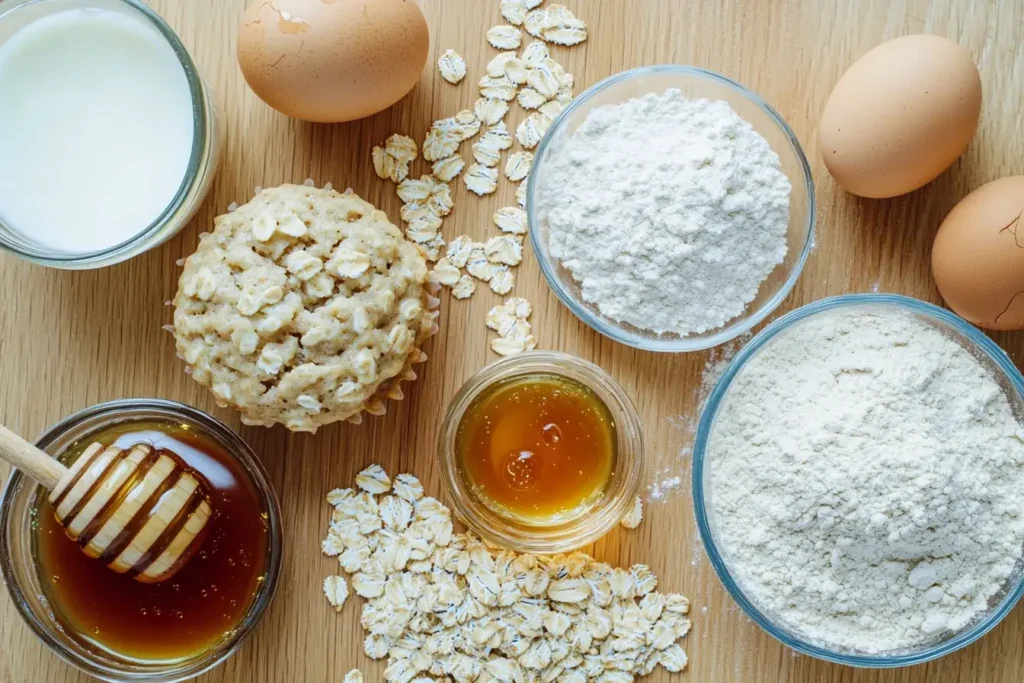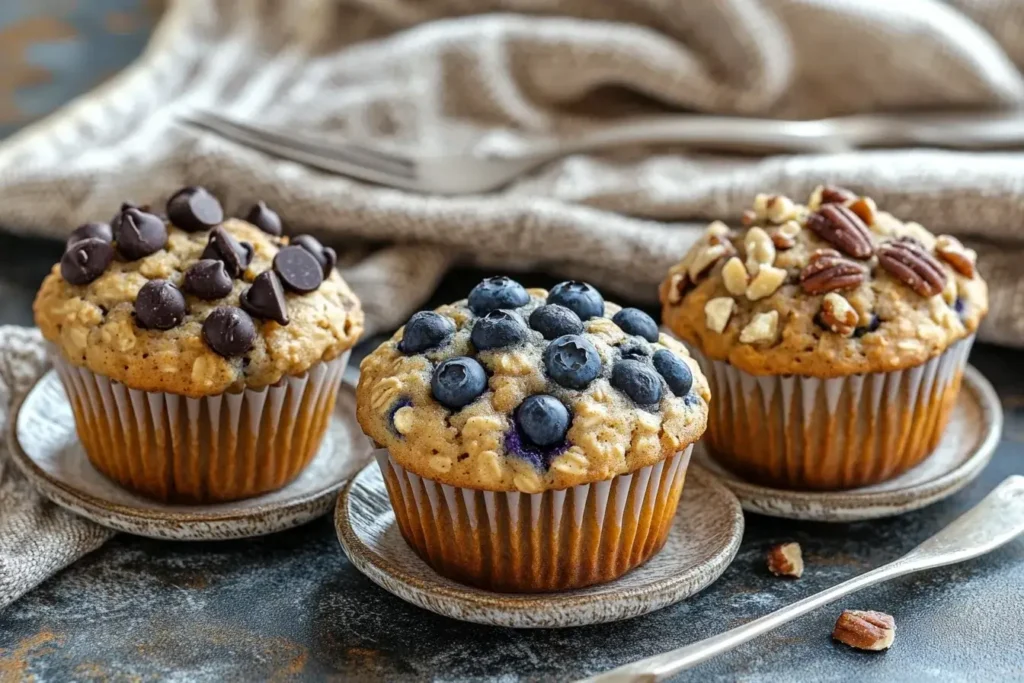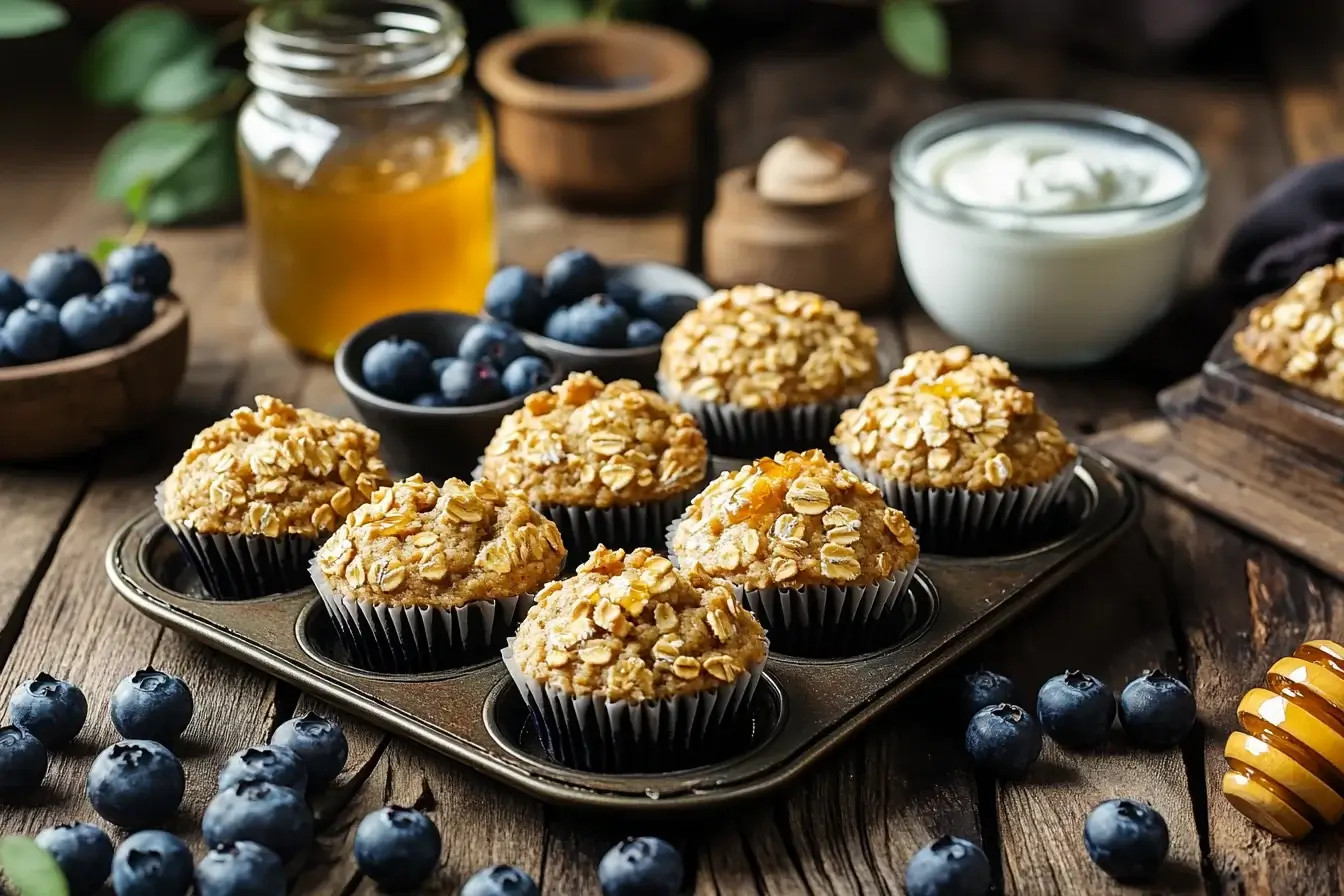Oatmeal yogurt muffins weren’t just born out of a healthy craving, they’re a reflection of my Southern roots and the soulful flavor philosophy that runs through everything I create. Growing up in a family where food meant togetherness, I learned early that nourishment isn’t just about calories—it’s about connection, creativity, and culture. My grandmother’s warm, spice-rich baking inspired me to look deeper into ingredients that comfort and energize. That’s how these muffins came to life, soft, satisfying, and full of flavor without compromise. After years in professional kitchens chasing perfection, I discovered the truth: healthy doesn’t have to mean bland, and indulgent doesn’t have to mean unhealthy. These muffins are that truth in bite-size form, a balance of whole grains, creamy yogurt, and warm spices. Perfect for mornings on the go, meal prep, or backyard brunches, they’re a staple in my flavor-forward kitchen. Ready to make your mornings better?
Let’s dive in.
Why Choose Oatmeal Yogurt Muffins?
Health Benefits of Oatmeal in Muffins
Oatmeal yogurt muffins are more than just a breakfast idea—they’re a wholesome bake filled with whole grains and lasting benefits for your body. When used in muffins, oats add texture, depth, and a nutty richness that pairs perfectly with both sweet and savory flavors. But beyond flavor, oats are rich in beta-glucan, a type of soluble fiber known for helping lower cholesterol and support heart health. According to the Harvard School of Public Health, fiber plays a key role in digestion and long-term wellness
They’re also packed with slow-digesting carbs, which means oatmeal yogurt muffins won’t give you a sugar crash like most store-bought pastries. Instead, they offer long-lasting energy, a perfect option for breakfast, pre-workout snacks, or a mid-afternoon bite.
For those watching their glycemic load, oats help balance blood sugar better than refined flour, especially when paired with the protein from yogurt. You get sustained energy and satisfaction, minus the spike-and-crash cycle of sugary baked goods.
Why Yogurt Makes Muffins Moist and Nutritious
Yogurt is a game-changer in muffin recipes. It adds a tender, moist crumb without the need for heavy amounts of butter or oil. Greek yogurt in particular delivers a double dose of benefit—moisture and protein, which gives these muffins a soft, cake-like texture while also making them more filling and nutrient-dense.
Yogurt’s natural acidity also reacts with baking soda, helping your muffins rise beautifully without the need for artificial leaveners. And let’s not forget the flavor, yogurt adds a subtle tang that complements the earthiness of oats and balances out sweetness from fruits or honey.
Looking for inspiration? Try our twist on classics like these coffee cake muffins for more breakfast-friendly ideas. You’ll see how yogurt transforms texture in baked goods, all while keeping things light and nutritious.
In short: yogurt gives muffins structure, softness, and staying power. It’s not just a healthy swap—it’s a flavor upgrade.
Key Ingredients That Make the Difference
Choosing the Right Oats: Rolled vs. Quick Oats
Not all oats are created equal, especially when it comes to baking. The two most commonly used types in muffin recipes are rolled oats and quick oats, and your choice can significantly affect the final texture.
Rolled oats, also called old-fashioned oats, are thicker and hold their shape better. They provide a hearty texture and rustic appearance, ideal if you want a more substantial bite. When soaked in yogurt, they soften just enough to blend seamlessly into the batter while still maintaining some chew.
Quick oats, on the other hand, are more processed and cook faster. They dissolve more easily into the muffin mix, giving a smoother, cake-like crumb. If you’re aiming for light, fluffy muffins with less texture, quick oats are the way to go.
Whichever you choose, make sure your oats are 100% whole grain and unsweetened. Avoid flavored or instant oatmeal packets—they often contain added sugars or artificial ingredients that can throw off the flavor balance and nutrition profile of your muffins.
Greek Yogurt vs. Regular Yogurt in Muffins
One of the most common questions in baking is whether to use Greek yogurt or regular yogurt, and when it comes to oatmeal yogurt muffins, both can work, but the difference matters.
In oatmeal yogurt muffins, Greek yogurt creates a thicker, creamier texture and boosts protein thanks to the straining process. It adds a rich, velvety texture to your batter and gives muffins a more substantial, bakery-style finish. It’s also lower in sugar and higher in probiotics, making it a smart choice for gut health and satiety.
Regular yogurt, by contrast, has a looser consistency and more moisture. It will produce a softer, lighter muffin with a slightly tangier flavor. It’s great if you want your muffins to feel more delicate and airy.
Pro Tip: Use plain, unsweetened yogurt, flavored yogurts often include hidden sugars and artificial flavorings that can overpower your muffin’s natural ingredients.
How to Make Oatmeal Yogurt Muffins from Scratch
Essential Tools and Smart Prep Tips
Getting oatmeal yogurt muffins just right starts with a little preparation—and no, you don’t need fancy baking tools to make it happen. Whether you’re baking on a busy weekday morning or meal-prepping for the week, these basics will set you up for success.
Kitchen Tools You’ll Need:
- 12-cup muffin tin – Line it with paper liners or use silicone for easy cleanup.
- Use two mixing bowls — one designated for dry ingredients, the other for wet.
- Whisk & spatula – A whisk to blend liquids and a spatula to gently fold the batter.
- Measuring cups and spoons – Accuracy matters in baking.
- Ice cream scoop or large spoon – For evenly portioning your batter into the muffin cups.
Pro Prep Tips:
- Soak oats in yogurt for 10–15 minutes before mixing—this softens them and creates a more moist muffin.
- Always preheat your oven to 350°F (175°C). A consistent oven temp helps your muffins rise evenly.
- Don’t forget to grease your muffin tin or use liners to avoid sticking.
Step-by-Step: The Base Oatmeal Yogurt Muffin Recipe
This go-to muffin recipe is flexible, reliable, and flavorful. Feel free to personalize it afterward — for example, with blueberries, bananas, or chopped nuts.

Ingredients:
- 1 cup rolled oats
- 1 cup plain Greek yogurt
- 1 large egg
- ¼ cup honey or pure maple syrup
- ¼ cup olive oil or melted coconut oil
- 1 teaspoon vanilla extract
- 1 cup whole wheat or all-purpose flour
- 1 teaspoon baking powder
- ½ teaspoon baking soda
- ½ teaspoon cinnamon
- ¼ teaspoon salt
Instructions:
- In a bowl, mix oats and yogurt. Let them soak together for about 15 minutes. This gives the oats time to soften.
- Whisk the egg, honey, oil, and vanilla in a separate bowl.
- Mix the soaked oats into the wet ingredients until well combined.
- Combine the egg, honey, oil, and vanilla in another bowl and whisk until blended.
- Carefully fold the dry ingredients into the wet, mixing only until moistened. Don’t overmix, or you’ll end up with tough muffins.
- Use a scoop or spoon to fill muffin cups about ¾ full.
- Bake at 350°F for 18–22 minutes. The muffins are ready when a toothpick inserted into the center comes out clean.
- Allow them to cool in the tin for 5 minutes, then move them to a wire rack.
The result? Tender, lightly sweet muffins with a hearty bite, just the right amount of tang from the yogurt, and a touch of cinnamon warmth.
Delicious Flavor Variations to Try
Blueberry Oatmeal Yogurt Muffins
If you’re a fan of classic blueberry Oatmeal Yogurt muffins, you’ll love the oat-and-yogurt twist in this version. The juicy burst of berries pairs perfectly with the creamy tang of Greek yogurt and the hearty texture of oats. For best results, use fresh or frozen blueberries—just toss them in a bit of flour before folding into the batter to prevent them from sinking.
Flavor Tip: Add a touch of lemon zest or a squeeze of lemon juice for a bright pop of flavor. It elevates the berries and balances the sweetness beautifully.
Want to explore more fruity muffin styles? Check out these coffee cake muffins for inspiration—they’re proof that fruit and crumble topping are always a good idea.
Banana Nut Oatmeal Yogurt Muffins
Looking for a cozy, comforting muffin? Bananas and oats make the perfect base for oatmeal yogurt muffins that taste indulgent but stay healthy.. Add overripe mashed bananas to your base batter and you’ll instantly boost moisture, flavor, and natural sweetness. Stir in chopped walnuts or pecans for added crunch and nutrition.

Substitution Tip: If you’re trying to cut back on sweeteners, bananas are a great natural replacement for honey or syrup. They also make the muffins extra soft and tender.
Flavor Boosters:
- A pinch of nutmeg or clove
- A tablespoon of flaxseed or chia for added fiber
- Mini chocolate chips for a kid-friendly version
Whether you’re craving fruity brightness or warm, nutty depth, these oatmeal yogurt muffins are a blank canvas for creativity. Mix, match, and make them your own.
Nutrition Facts and Health Tips
Calorie Count & Macronutrient Breakdown
When you bite into oatmeal yogurt muffins, you’re enjoying not just a tasty treat—but fueling your body with wholesome ingredients and balanced nutrition. Here’s a look at the typical nutrition profile for one standard muffin (based on the base recipe from Part 3):
| Nutrient | Per Muffin (approx.) |
|---|---|
| Calories | 160–180 kcal |
| Protein | 6–8g |
| Carbohydrates | 22–25g |
| Fiber | 2–3g |
| Sugars (natural) | 5–8g |
| Fat | 6–7g |
| Saturated Fat | 1g or less |
These muffins deliver balanced macronutrients, thanks to the mix of oats, yogurt, and optional add-ins like nuts or fruit. The Greek yogurt adds a boost of protein, while the oats provide complex carbs and dietary fiber—perfect for sustained energy.
Looking for another smart, flavorful option for fueling your day? Check out these Low Calorie Brownies that also focuses on balance and taste.
How to Make These Muffins Low-Calorie or High-Protein
One of the best things about oatmeal yogurt muffins is how easy they are to customize. Whether you’re watching your calorie intake or aiming to hit protein goals, here’s how to tweak the base recipe:
For Lower Calories:
- Use low-fat Greek yogurt or plain nonfat yogurt
- Replace oil with unsweetened applesauce (1:1 ratio)
- Reduce sweetener to 2 tablespoons or skip altogether if using ripe bananas
For Higher Protein:
- Add 1 scoop of vanilla protein powder (reduce flour slightly to balance)
- Include egg whites along with a whole egg
- Stir in chia seeds, hemp hearts, or nut butters for added protein and texture
Bonus Tip: These muffins already support blood sugar control thanks to the fiber and protein content—but you can amplify the benefit by pairing them with a boiled egg or a small smoothie for a fully balanced breakfast.
Expert Baking Tips for Perfect Texture
How to Keep Muffins Moist and Fluffy
The biggest struggle with homemade muffins? Dryness. But when you’re baking oatmeal yogurt muffins, you’ve already got two powerful moisture-retaining ingredients—oats and yogurt—on your side. Still, a few pro tricks can take your muffins from good to exceptional.
Top Tips for Moist, Fluffy Muffins:
- Soak your oats in yogurt before mixing. This step lets the oats absorb moisture rather than drawing it from the rest of the batter.
- Don’t overmix. Gently fold your ingredients just until combined. Overmixing develops gluten, which leads to dense, chewy muffins.
- Use room temperature ingredients. Cold eggs or yogurt may cause the batter to mix unevenly and hinder the muffins from rising properly.
- Stick to the bake time. Overbaking dries out muffins fast. Start checking them at the 18-minute mark.
Avoiding Common Muffin Mistakes
Even with the best ingredients, small missteps can ruin a batch of oatmeal yogurt muffins, but a few simple tricks keep them soft and fluffy.
| Mistake | Fix It With This Tip |
|---|---|
| Overbaking | Always test with a toothpick at 18 mins |
| Dense texture | Don’t overmix, and check freshness of leaveners |
| Flat muffins | Make sure your baking soda and powder are active |
| Soggy bottoms | Use paper liners or let muffins rest on a rack |
Bonus Insight: If you want golden tops with a bakery-style dome, preheat your oven to 425°F, then reduce to 350°F after placing the muffins inside. The initial heat boost helps them rise fast.
If you’ve ever wondered why some muffins fall flat while others puff perfectly, this tip alone will change your baking game.
Storing, Freezing & Meal Prepping Muffins
Best Storage Practices for Freshness
One of the best things about oatmeal yogurt muffins is how well they hold up after baking. Whether you’re enjoying them the next day or freezing them for later, a few simple storage tips can help you lock in moisture and flavor.
Short-Term Storage (Up to 3 Days):
- Allow muffins to cool fully before storing to avoid sogginess.
- Place them in an airtight container lined with paper towels to absorb excess moisture.
- Store at room temperature, shielded from direct sun and heat.
Reheating Tip: To bring back their just-baked texture, heat a muffin in the microwave for 10–12 seconds or in a toaster oven for a few minutes.
Freezer-Friendly Tips for Busy Mornings
Need breakfast in a hurry? These Oatmeal yogurt muffins freeze wonderfully and warm up soft and fresh, never rubbery or dry.
Freezing Instructions:
- Cool muffins completely.
- Wrap each muffin on its own using foil or plastic wrap.
- Place wrapped muffins in a large zip-top freezer bag or airtight container.
- Label with the date—they’ll stay fresh for up to 3 months.
Reheating From Frozen:
- Microwave: 30–40 seconds on high (remove wrap first)
- Oven: 10 minutes at 300°F
You can also thaw them overnight in the fridge if you like to plan ahead.
Need a full flavor-packed meal prep idea? Pair these muffins with a protein smoothie or even a savory egg dish like our garlic butter eggs recipe for a balanced and satisfying breakfast lineup.
Meal Prep Hack: Bake a double batch on Sunday—store half for the week and freeze the rest for the following week. Just like that, your mornings are handled.
Pairing & Serving Suggestions
What Goes Well with Oatmeal Yogurt Muffins
Oatmeal yogurt muffins are wonderfully versatile, making them an easy fit for any time of day. Whether you’re serving brunch to a crowd or just looking to elevate your breakfast routine, here are some delicious pairings that highlight their wholesome, cozy flavor:
For Breakfast:
- A warm muffin with a side of scrambled eggs or garlic butter eggs for protein and balance
- Fresh seasonal fruit (berries, sliced bananas, or citrus segments)
- A cup of strong coffee or a matcha latte
For Snacks or Midday Fuel:
- A muffin topped with nut butter (almond, peanut, or cashew)
- Yogurt with a drizzle of honey and granola
- A handful of mixed nuts or trail mix
For Brunch Hosting:
- Present warm muffins in a basket next to mini quiches or a vibrant salmon Caesar salad.
- For a touch of sweetness, finish with a light glaze or cream cheese icing.
- Pair with fresh juices or mimosas for a more festive vibe
Ideas for Breakfast, Snacks, or Brunch
Need to serve a crowd or simply love options? Here are creative ways to present your oatmeal yogurt muffins:
| Occasion | Serving Idea |
|---|---|
| On-the-go | Wrap individually and pair with a protein bar |
| Office snack | Pack with cheese cubes and fruit in a lunch box |
| Weekend brunch | Serve warm with whipped cinnamon butter |
| Kids’ treat | Add chocolate chips and a drizzle of honey |
| Light lunch | Pair with salmon and shrimp salad and iced tea |
Want more ideas for balanced meals that don’t sacrifice flavor? Check out this shrimp garlic recipe—a savory dish that makes a fantastic brunch companion.
No matter how you serve them, oatmeal yogurt muffins offer a comforting, satisfying bite that pairs easily with sweet or savory sides—proof that healthy food can be both functional and flavorful.
Comparing Muffins: Healthiest Options Ranked
Oatmeal Yogurt Muffins vs. Store-Bought Muffins
Store-bought muffins may look convenient, but a closer look at the label often reveals a not-so-sweet truth—loaded with sugar, refined flour, and empty calories. In contrast, oatmeal yogurt muffins are built on whole ingredients, offering a more nourishing alternative without sacrificing taste.
Here’s a side-by-side comparison:
| Feature | Oatmeal Yogurt Muffins | Store-Bought Muffins |
|---|---|---|
| Main Ingredients | Oats, yogurt, eggs, honey | White flour, sugar, vegetable oil |
| Sugar Content (per muffin) | 5–8g (natural sweeteners) | 20–30g (refined sugar) |
| Fiber | 2–3g | 0–1g |
| Protein | 6–8g (Greek yogurt, eggs) | 2–4g |
| Additives/Preservatives | None | Often included |
| Texture | Moist, hearty, naturally sweet | Often overly sweet, crumbly |
The verdict? Homemade oatmeal yogurt muffins win on every front—better texture, cleaner ingredients, and more nutritional value.
Other Healthy Muffin Recipes to Try
Once you master oatmeal yogurt muffins, it’s hard not to fall in love with other wholesome variations. Here are a few healthy muffin types to try next:
- Zucchini Muffins – Add grated zucchini for moisture and nutrients without overpowering flavor.
- Pumpkin Oat Muffins – Packed with fiber and beta-carotene, ideal for the autumn season.
- Carrot Apple Muffins – Naturally sweet and packed with vitamins.
- Almond Banana Muffins – Dairy-free and high in protein.
All of these can follow the same oat-and-yogurt base, making them easy to adapt with seasonal or pantry ingredients.
Hungry for more flavor-packed ideas? Explore this creamy shrimp pasta that balances comfort with health—a great example of flavor-first cooking in action.
Conclusion: Oatmeal Yogurt Muffins That Nourish and Satisfy
Oatmeal yogurt muffins are more than just a wholesome breakfast—they’re proof that healthy can be flavorful and simple can be satisfying. With the creaminess of yogurt, the fiber-rich base of oats, and endless ways to customize them, these muffins fit right into your flavor-forward, wellness-minded lifestyle.
Whether you’re feeding a family, meal-prepping for the week, or just looking for a guilt-free treat, these muffins offer the perfect balance of nutrition, texture, and taste. Plus, you control the ingredients—so every bite supports your body and your cravings.
Looking for inspiration? Explore new flavors with coffee cake muffins. And if you’re feeling adventurous, pair your muffins with our flavor-packed shrimp garlic recipe for a fun brunch twist.
In a world where muffins are often an afterthought, let these be a reminder: simple, nourishing food can still be incredibly delicious.
FAQs: Answering Your Top Muffin Questions
What does yogurt do in baking muffins?
Yogurt adds moisture, richness, and a slight tang to muffins, making them softer and fluffier without needing a ton of oil or butter. The acidity in yogurt also reacts with baking soda, which helps the muffins rise and creates a tender crumb. Plus, it boosts protein content—especially if you use Greek yogurt.
Is oatmeal and yogurt a good combination?
Absolutely. Oatmeal and yogurt are a power couple in healthy baking. Oats provide complex carbs and fiber, while yogurt contributes protein and creaminess. Together, they balance flavor, texture, and nutrition. When soaked before baking, oats absorb the yogurt’s moisture, which makes muffins hearty but never dry.
What is the healthiest type of muffin?
The healthiest muffins are those made with whole grains, natural sweeteners, and minimal processed ingredients—exactly like oatmeal yogurt muffins. Skip store-bought versions full of refined flour and sugar. Instead, choose recipes that include fiber-rich oats, unsweetened yogurt, fruit, and nuts for sustained energy and nutrition.
Can I use Greek yogurt instead of milk for muffins?
Yes, and it’s often the better choice. Greek yogurt is thicker and creamier than milk, giving your muffins more moisture and richness. It also adds more protein and less sugar than most milk varieties. Remember to keep the batter balanced — Greek yogurt is denser, so you might want to cut back a bit on the flour.
How long can you store oatmeal yogurt muffins?
At room temperature, these muffins last up to 3 days in an airtight container. For longer freshness, refrigerate for up to a week, or freeze for up to 3 months. Just reheat in the microwave or oven for a warm, just-baked texture.
Can I make them gluten-free or dairy-free?
Definitely! For gluten-free muffins, substitute with certified gluten-free oats and equal-ratio gluten-free baking flour. For dairy-free, swap in a non-dairy yogurt (like almond or coconut) and use a neutral oil in place of butter. The texture and taste stay just as comforting and delicious.

Wholesome Oatmeal Yogurt Muffins
Ingredients
Equipment
Method
- In a bowl, stir together rolled oats and Greek yogurt.Let them soak for 15 minutes so the oats soften.
- In a large mixing bowl, whisk together the egg, honey (or maple syrup), oil, and vanilla until smooth.
- Fold the soaked oat mixture into the wet ingredients and mix until combined.
- In another bowl, whisk together the flour, baking powder, baking soda, cinnamon, and salt.
- Gently fold the dry ingredients into the wet mixture.Stir just until combined—do not overmix to keep muffins tender.
- Line or grease a muffin pan. Fill each cup about ¾ full with batter.
- Bake at 350°F (175°C) for 18–22 minutes.Check with a toothpick—it should come out clean when inserted in the center.
- Let muffins cool in the pan for 5 minutes, then transfer to a wire rack.
